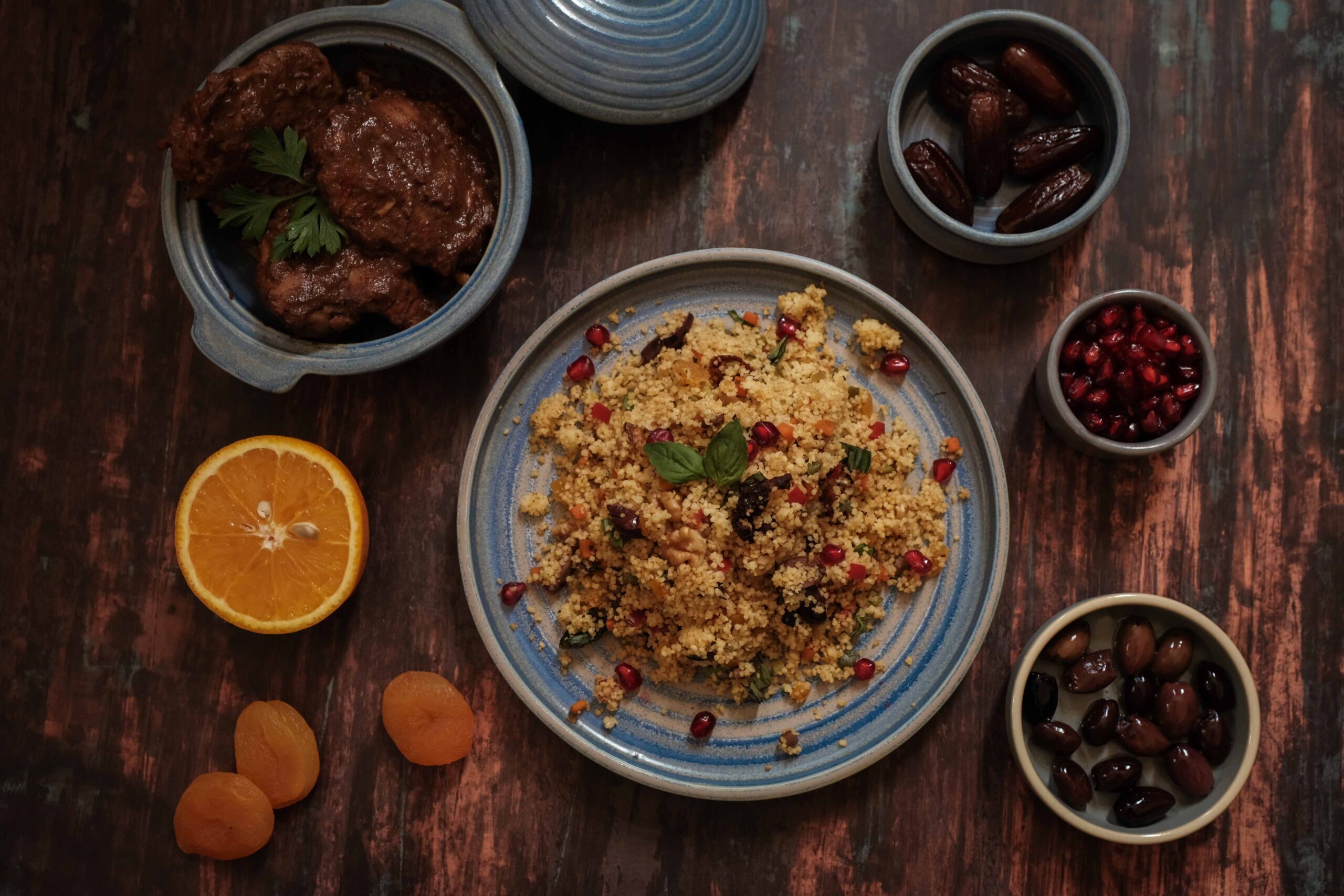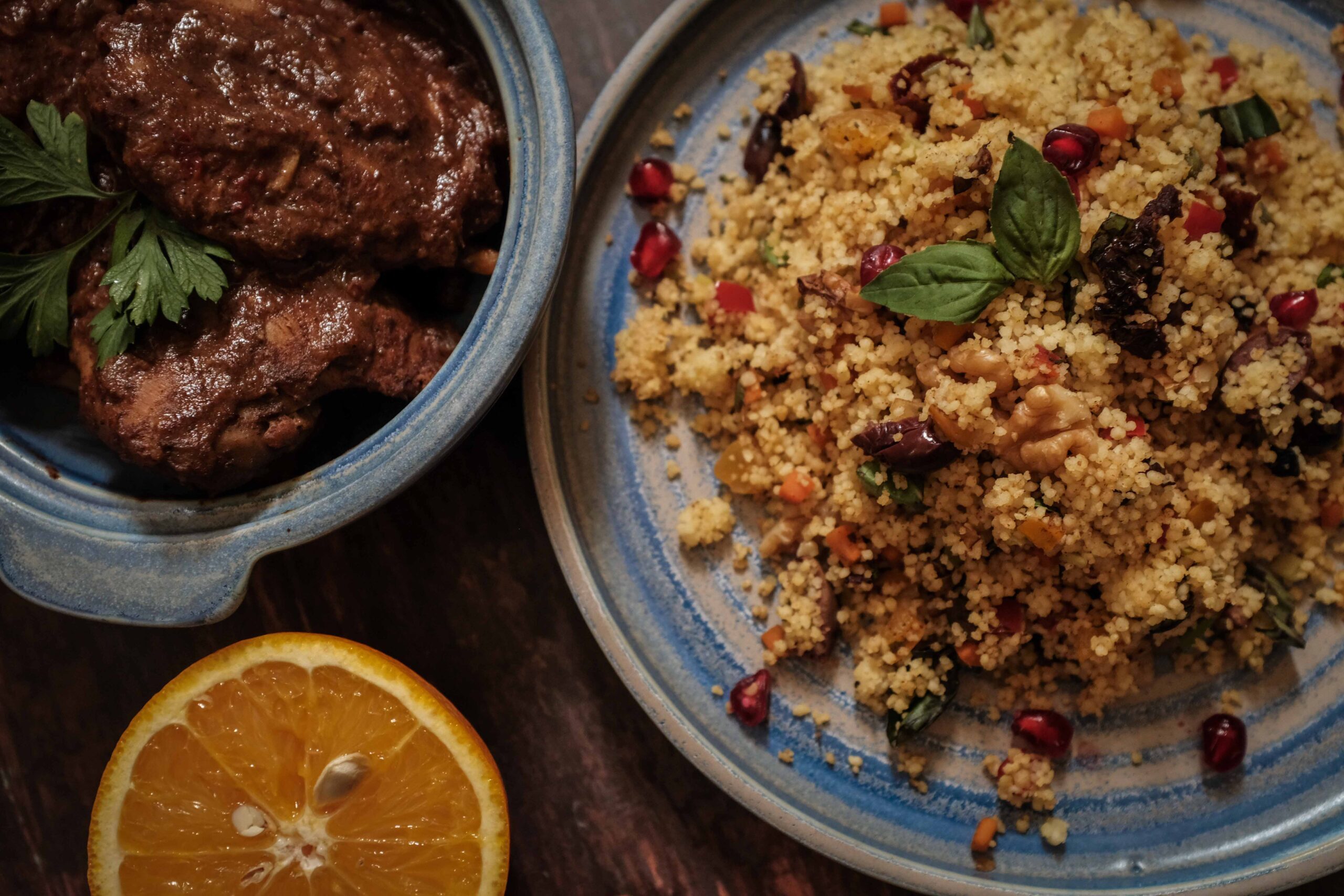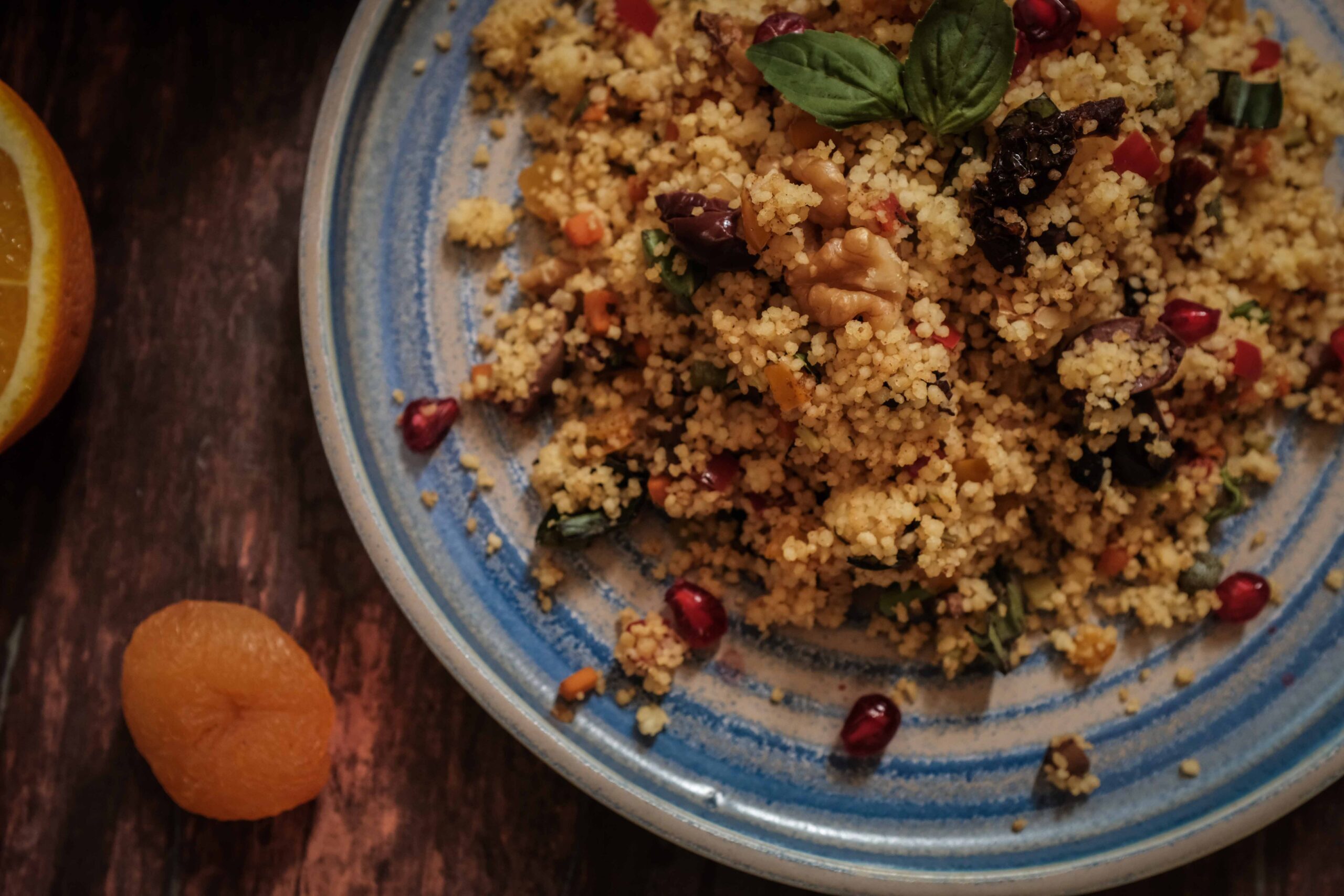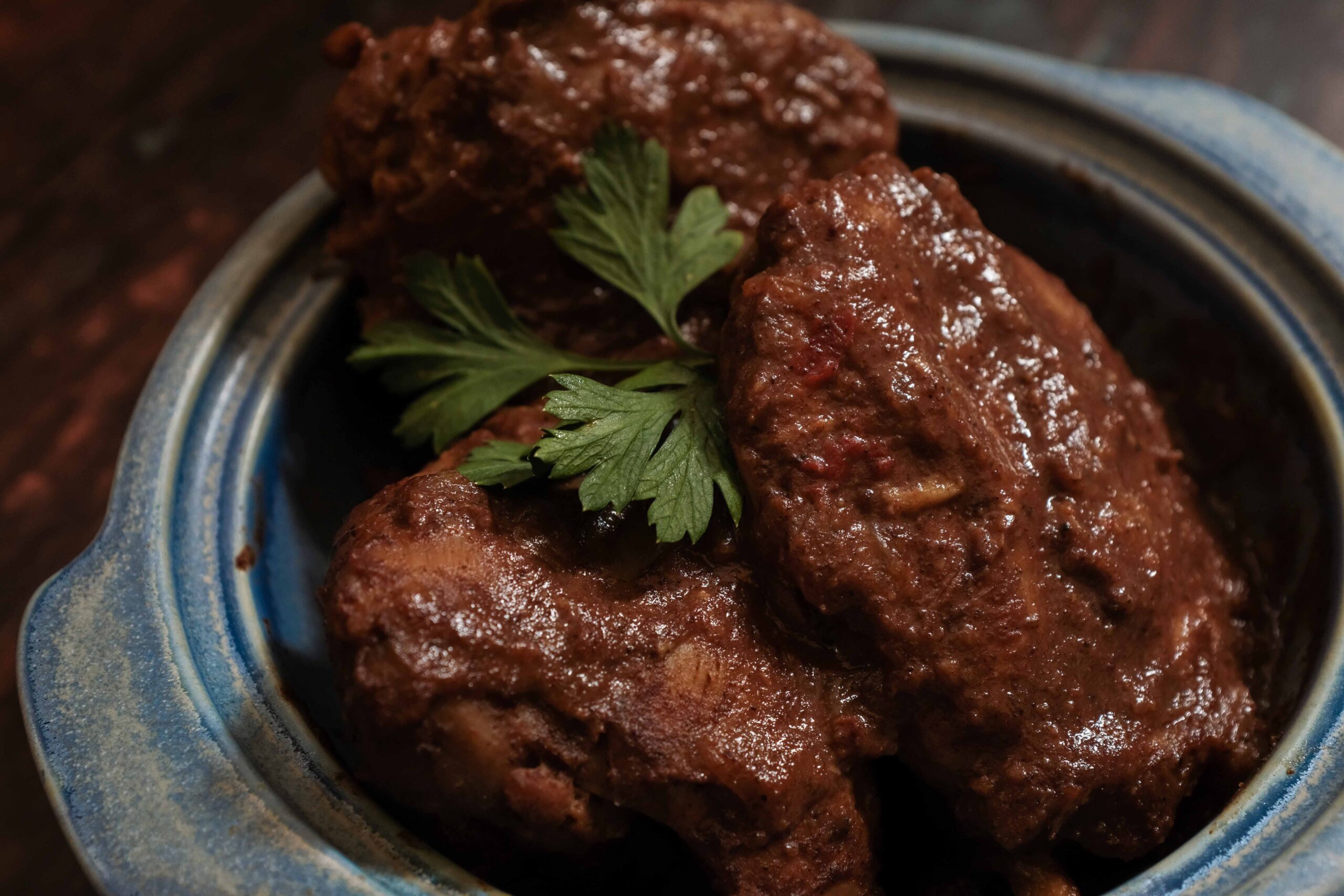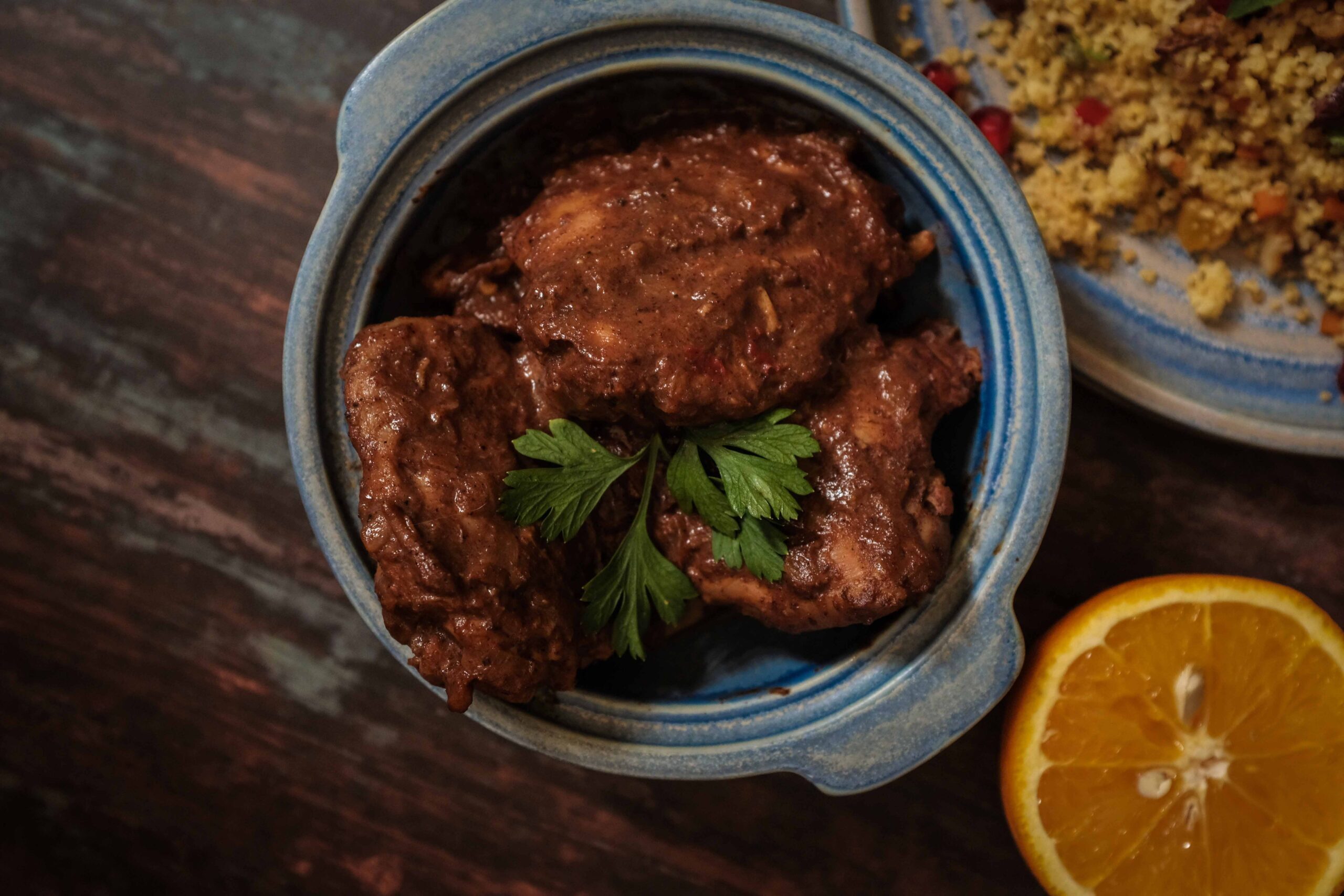Makes 4-6 servings.
I discovered this dish when I was 18, exactly 18 years ago. Back then, it distinctly belonged to Southern Europe. Over time, it has evolved into a stateless island, influenced by all the lands that touch the Mediterranean Sea between Morocco and Turkey. Here, cinnamon is friends with saffron. Cumin hangs out with parsley. Caraway and paprika fraternise. There are no borders or laws; just unorthodox flavour combinations that warmly fuse together in culinary Xanadu.
At a glance
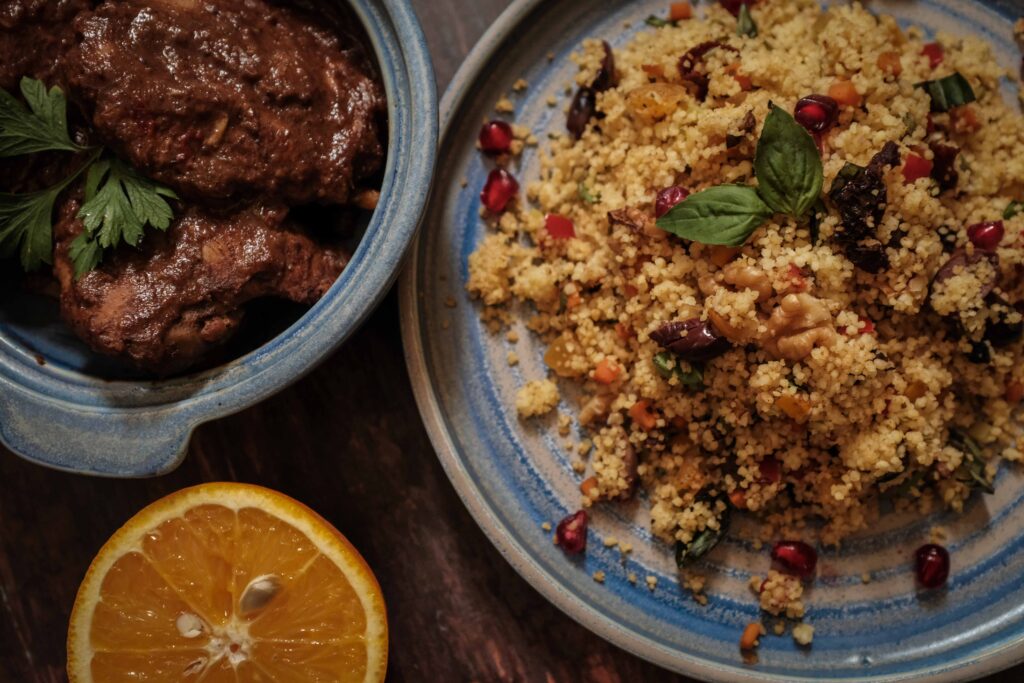
– This dish comprises cinnamon chicken + vegan couscous ‘pilaf’
– You will need a big cooking pot (4-5 litre capacity) and a wide skillet or frying pan.
– This recipe has been broken into 2 stages for ease and comprehension. Please read the entire recipe from start to finish before beginning.
Stage 1: cinnamon chicken
Ingredients
1. 10 chicken thigh pieces (bone-in, skinless)
For the marinade:
2. 3-4 fresh red chillies (the thin and long, not too hot kind)
3. 6-7 medium pods of garlic, (or 1 tbsp. garlic paste)
4. 1 tsp caraway seeds (shahi jeera)
5. 1 tsp coriander powder
6. 2 tsp cumin powder
7. ½ tsp freshly ground black pepper
8. 1 tbsp. salt
9. 1 tbsp. white wine vinegar
10. 1 tbsp. extra virgin olive oil
11. 1 tsp. freshly grated lemon zest
This marinade is designed to emulate the taste of harissa with a lot less chilli. You could use store-bought or homemade harissa as well, but I like to control the chilli and spice amounts. This is a sweet, mildly spiced dish. Add as many red chillies as you like to yours. To grind this small an amount of marinade, I find that using a mortar and pestle is best.
For the cook:
12. 2 tbsp. cooking olive oil
13. 2 medium onions, finely diced
14. 8-10 medium garlic pods lightly smashed
15. 150 ml dry white wine
16. 300 ml chicken stock, heated
17. 6-8 saffron strands
18. 1½ tbsp. finely ground cinnamon powder + 50 ml warm water
19. 20 whole and pitted Zahidi or Deglet Noor dates.
20. 20 gm tomato paste
21. Small bunch fresh flat leaf parsley, to yield 1/4th cup chopped parsley
22. Additional salt, to taste
When using cinnamon in this recipe, please look for Ceylon Cinnamon (true cinnamon) powder. Ground Cassia chips (dalchini/darchini) should not be substituted, as they’re not the same thing. Cinnamon is made from the trunk of the tree; and is very fragrant, tastes sweet, and is milder than Cassia. On the other hand, Cassia is made from the bark of the cinnamon tree—and is much coarser, harder, and spicier—making it unsuitable in this dish. Cassia is best used sparingly or as whole chips; to lend a warm note to curries, stews, and more. Plus, because it’s so hardy, you’ll never be able to get a really finely ground powder using cassia chips, no matter how powerful your home grinder. This will make your sauce gritty, unpleasant, and really hard to swallow. Whenever I add cinnamon powder to a liquid, I always make a thick paste and then add it, as that’s the easiest and fastest way to incorporate it. Added directly, the airy cinnamon powder floats around in little bubbles and doesn’t get properly mixed into the sauce.
Prep
1 – Make the marinade. In a small pan, toast the caraway seeds on low heat for 2-3 minutes or until aromatic. Take care not to burn them. Transfer the seeds to a mortar and pestle. Wait until the seeds have cooled down and then pound them to a fine powder consistency. In a blender jar or mortar, place the red chillies, garlic pods, ground caraway seeds, coriander and cumin powder, ground black pepper, salt, white wine vinegar, extra virgin olive oil, and freshly grated lemon zest. Grind the contents until they come together as a thick, smooth paste.
2 – Wash the chicken pieces and pat them dry. Marinate the chicken pieces with the freshly prepared marinade. Set aside for a minimum of 60 minutes.
3 – Heat up your chicken stock. I used one whole chicken stock cube in 300 ml hot water. Sprinkle the saffron strands in the warm stock to infuse them.
4 – Dice your onions and lightly smash your garlic.
Method
1 – In a large heavy bottomed pot, heat up 1 tablespoon of olive oil till shimmering. Then lower the flame to medium.
2 – Add the finely diced onions to the pot and begin frying them on low-medium heat. This is a brown curry, so you want to caramelise the onions, low and slow, for 12-13 minutes.
3 – When the onions become light golden, turn the heat to low and toss in the lightly crushed garlic pods. Continue sautéing till both the onions and the garlic are a light golden brown, 3-4 minutes.
4 – Add the marinated chicken pieces along with their marinade to the pot. Sear the meat, frying the pieces on medium-high for approximately 8 minutes or until the chicken pieces are browned. Do not ‘stew’ them on low heat, nor burn or blacken any of the spices, aromatics, or the chicken.
5 – Add the white wine and deglaze the pot. Braise the chicken on medium-high for 3-4 minutes or until you can no longer smell the alcohol.
6 – Add the warm, saffron-infused chicken stock to the pot. Stir to combine. Bring the pot to a gentle, steady simmer.
7 – In the meantime, mix 2 tablespoons of cinnamon powder with 50 ml warm water. Stir the cinnamon paste well to ensure that there are no lumps or air bubbles. When the pot comes to a simmer, add the cinnamon paste and stir everything together.
8 – Add the dates to the pot. Then cook the chicken on medium heat for 10-15 minutes, uncovered. The mixture should gently bubble. Cook time will depend on the size of your pieces. Stir the pot occasionally to prevent sticking.
9 – After 10-15 minutes, stir in the tomato paste. Simmer for another 2-3 minutes.
10 – Your chicken is cooked at this point. Check it for seasoning. Add salt if desired (I don’t, as there’s enough sodium in the chicken stock). If you like a thinner gravy, turn off the heat now. If you like a glossy, luscious, glaze-like consistency, reduce it till you reach that stage. Since we’re using thigh pieces, a little overcooking won’t dry the meat out. When you’re done, turn the heat off.
11 – Don’t put in the fresh parsley yet, as that will be added right before serving. Your cinnamon chicken is ready! Rest it for at least 15 minutes before serving, or set it aside and move on to Stage 2.
Cinnamon chicken tastes even better the day after it has been cooked and can be made in advance and stored in the fridge. Reheat your chicken and garnish it with chopped fresh parsley before serving.
Stage 2: vegan couscous ‘pilaf’
Although the overall dish features chicken, I decided to make this component vegan because it’s so darn delicious and everyone deserves to taste it regardless of their food choices! I often make this without any meat to accompany it and serve it solo, as a meal in itself.
Ingredients
1. 360 gm instant Moroccan couscous
For the cooked couscous mixture:
2. 1 tsp cooking olive oil
3. ½ medium onion to give 1/3rd cup brunoised onions
4. 2 medium pods of garlic, finely minced
5. 1 small carrot (85gm) to give 1/3rd cup brunoised carrots
6. 10-inch celery stalk to give 1/4th cup brunoised celery
7. 50 gm Portobello mushrooms to give ½ cup brunoised mushroom
8. ½ of a small red capsicum, to give ½ cup brunoised red capsicum
9. ½ of a small yellow capsicum to give ½ cup brunoised yellow capsicum
10. 1 tsp. cumin powder
11. ½ tsp dried parsley
12. 1 tsp sweet paprika
13. 1 tsp smoked paprika
14. ¼ tsp pepper
15. 1/8th tsp nutmeg
16. 1 tsp salt
For the uncooked couscous mixture:
17. 2 large Turkish dried apricots, chopped into small chunks
18. 20 Kalamata olives, pitted and sliced in half
19. 4 mini gherkins, finely diced (brunoised)
20. 1/8 cup capers, whole
21. 10 rehydrated sun dried tomatoes, roughly chopped up
22. 6 whole walnuts, roughly broken
23. 1/3 cup pomegranate arils
24. ¼ cup fresh basil, finely chopped
For the couscous stock
25. 400 ml hot vegetable stock (8 gm vegetable bouillon broth powder + 400 ml hot water)
26. 100 ml freshly squeezed orange juice ( I used Valencia oranges)
27. 2 tbsp. extra virgin olive oil
28. 1 tsp salt (or to taste)
Prep
1 – Mince your garlic.
2 – Brunoise-cut (finely dice) your onion, carrot, celery, mushroom and bell peppers. They needn’t be perfectly symmetrical, but you’re looking for 1/8th inch cubes of veg.
3 – Dice your gherkins, and chop up your olives and sundried tomatoes.
4 – Dice your apricots into 1/8th inch cubes.
5 – Deseed your pomegranate and collect one-third cups’ worth of arils.
6 – Break your walnuts into rough kernels.
7 – Weigh out your couscous. Place it in a large bowl and set it aside.
8 – Measure out your vegetable stock. Add 1 teaspoon of salt to the stock.
9 – Measure out your orange juice and keep it in a heat proof bowl.
Method
1 – In a wide skillet or pan, heat up 1 tsp of cooking olive oil, until shimmering. Lower the heat to minimum.
2 – Add the finely diced onion and minced garlic and sauté on low heat until they are aromatic, 3-4 minutes. Do not brown.
3 – Add in the diced carrot and celery and continue sautéing till lightly softened, about 4 minutes. Do not brown.
4 – Add in the cumin powder and dried parsley. Give it a mix and continue to sauté for a minute.
5 – Raise the heat to medium. Add the diced red and yellow bell pepper, sauté for 2-3 minutes. Do not brown.
6 – Add the diced mushroom to the pan. Continue to sauté on medium for 2-3 minutes. Do not brown.
7 – Turn the heat off. Sprinkle in the salt, the two types of paprika, pepper, and nutmeg. Toss the hot mixture with the spices and set it aside to cool. All the veg should be their original colour and shape. This makes for a riotous, colour speckled, be-jewelled couscous.
8 – Keep some cling wrap handy. Heat up your vegetable stock till it comes to a boil and then turn the heat off. Heat up your orange juice until it is just hot (80OC). Add the extra virgin olive oil, the vegetable stock, and the orange juice to the bowl with the couscous. Give the mixture a quick stir and cover it immediately with cling wrap. Leave it to steam undisturbed for 10 minutes.
9 – In the meantime, chop up your basil.
10 – After 10 minutes, remove the cling wrap and gently fluff up the couscous with a fork, the way you would fluff up steamed rice. The ‘grains’ should be separate but whole.
11 – Add the cooked veg mixture to the couscous. Add the chopped olives, gherkins, sun dried tomatoes, and the capers. Add the diced apricots and the pomegranate arils. Finally add the chopped fresh basil and the broken walnut kernels. Gently combine everything together with a large metal spoon.
12 – Taste the mixture. Add salt if desired. Your couscous ‘pilaf’ is ready.
13 – Just before eating, top your cinnamon chicken with fresh parsley leaves and serve it with a side of couscous pilaf. Now eat!
A true pilaf is a spiced rice preparation. And although couscous appears to be a grain, it is in fact a kind of pasta, usually made with durum wheat or barley. There are 3 main types of couscous; Moroccan couscous – which resembles cracked wheat (dalia), Israeli/Pearl couscous – which is the size of peppercorns, and Lebanese couscous – which is pea-sized. Traditional couscous is steamed over a bubbling broth in a vessel called a ‘couscoussier’ and is fairly complicated and time-consuming to make. Where I live, instant Moroccan couscous is readily available, so that’s what I use. You could use any kind that you like for this dish. To rehydrate instant Moroccan couscous, you generally need to soak it in an equal volumetric measure of hot liquid; that is, 1 cup couscous requires 1 cup of hot liquid. However, depending on the brand you buy, the amount of liquid may differ. Check your package for instructions.

